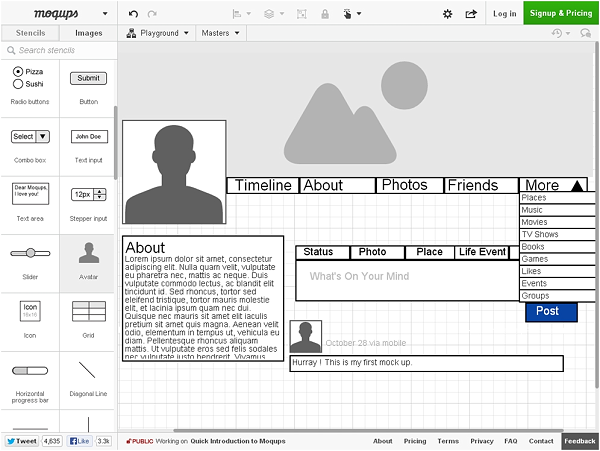Where do you start when you want to build a website? The main goal is to figure out how and why the user will interact with your site. But what technologies do you need to know and use in order to succeed? If you follow the next steps in this guide we can help you figure out the best process for planning your new web project.
Let's take a look at the typical website development process. Here are 7 steps that are always relevant for any web development project.
1. Purpose of the Project
The first step is to gather all the information about the project you are building. For instance, first ask the questions:
- Who is your website's target audience?
- What purpose does it need to serve?
- What do we want the user to do on the site?
You need to have a clear answer to these questions before you begin.
You may find that answering these questions will lead you to other questions you didn't think of.
Useful Tip: For any project, you have to focus on saving people time and effort. If they struggle to navigate thru your website, they are more likely to leave and never come back. The faster they can get to the information they are looking for, the better.
2. The Sitemap
A sitemap is essentially an outline for the entire website, and it's very important to have this before you begin. The role of the sitemap is to provide an understanding of how the whole website sections will link to each other. This is important for understanding the scope of your project, as well as providing search engines with an understanding of what the website is about.
The sitemap allows you to understand the structure of the website. Any changes on the structure can have a huge time impact on the delivery of the project, so be sure to communicate with your clients or stakeholders before you proceed past this planning step.
You can use a few tools for generating your sitemap:
Slickplan $/Free Trial
Dynomapper $/Free Trial
WriteMaps Free/$
Screaming Frog XML Sitemap Generator Free
For the user interface, you can use tools like Moqups to create a wireframe. A wireframe is a visual representation of how the website will look for the users. The wireframe should be simple, don't go into too much detail on visual design. More important is showing how users can navigate thru the website on "user journeys".

3. Design and user experience
This is the step where the website is mocked up before it is coded. Everything that has to do with visual content is added here: images, illustrations, videos, icons, and other content. Everything is built on the information gathered together at the first two steps. This is where you get fill in the logos and agree with the client on the color combinations,
On this step it is very important to focus on the user experience. This is where the web designer comes in place. He or she creates the look, layout and visual features of the website using tools such as Photoshop, Sketch, or Illustrator. He or she has to have a very good general understanding of the whole project and what it wants to deliver. The designer works very closely with the developers and project managers to make sure that all the needs are met.
You can have a few testers on this step to see what they think about the whole flow of the website. After the feedback, if some of the users think that they got stuck somewhere or find the functionality difficult to use you need to rethink that aspect. You have to repeat this process until the whole flow works smoothly.
4. Populating the website
Probably this is the most important aspect of them all. This is where you fill in all the information you want to deliver and create the rest of the content needed. This is usually the client's job, but sometimes is done in tandem with the development team. This is a time consuming task as you have to create catchy headlines, write and edit the text, and think about the call to actions. It is recommended to have all the information provided before you start coding.
5. Coding
This is where you create the website itself from the mockup. You start developing based on all the mockups provided at the previous steps. All the graphic elements are coded into the HTML and CSS of the site. It is mandatory that you create a fluid application that is responsive and works across all mainstream devices. You can use the sitemap at this step and start developing in the same manner. You start with the homepage and and then create all the subsidiary pages. This is where you test the server and all domain and URL related issues. Valid code is important for page semantics and also for SEO.
6. SEO
Another key aspect of the process is the SEO (Search Engine Optimization). Basically you have to make sure that all the titles. descriptions and keywords are up to date and can help you achieve higher ranking in the search engines. The higher you place in the rankings, the easier is for people to find your business therefore you have more potential clients.
7. Launching and maintenance
Before you release the whole project to the public and push everything to live you have to make sure that you go though some thorough testing. Every link should be tested, make sure that all the buttons work and all the forms work properly. After you double check everything you can use FTP (File Transfer Protocol) or SFTP (Secure File Transfer Protocol) to upload documents to your web host that is linked with your domain name. After the deployment of your new website you should make sure that every thing works fine and run another final test to make sure everything is going smoothly.
The work isn’t finished when a website is live. On some aspects it’s just starting. You have to check periodically if there are any issues and be ready to fix them quickly as in the more downtime your website gets the more potential business you may end up losing. You always have to be prepared for more changes and updates over time. Another way you can make money over time is charging clients for maintenance work.
Conclusions
Considering all the steps above you should always keep an eyes for websites that inspire you. Good luck in all you future web development experiences and don’t forget to regularly monitor your website, improve security, and update it every month. Technology always changes in an incredible fast manner, and you will need to keep up with the changing requirements and trends.





0 Comments
Leave a Reply
Your email address will not be published. Required fields are marked *